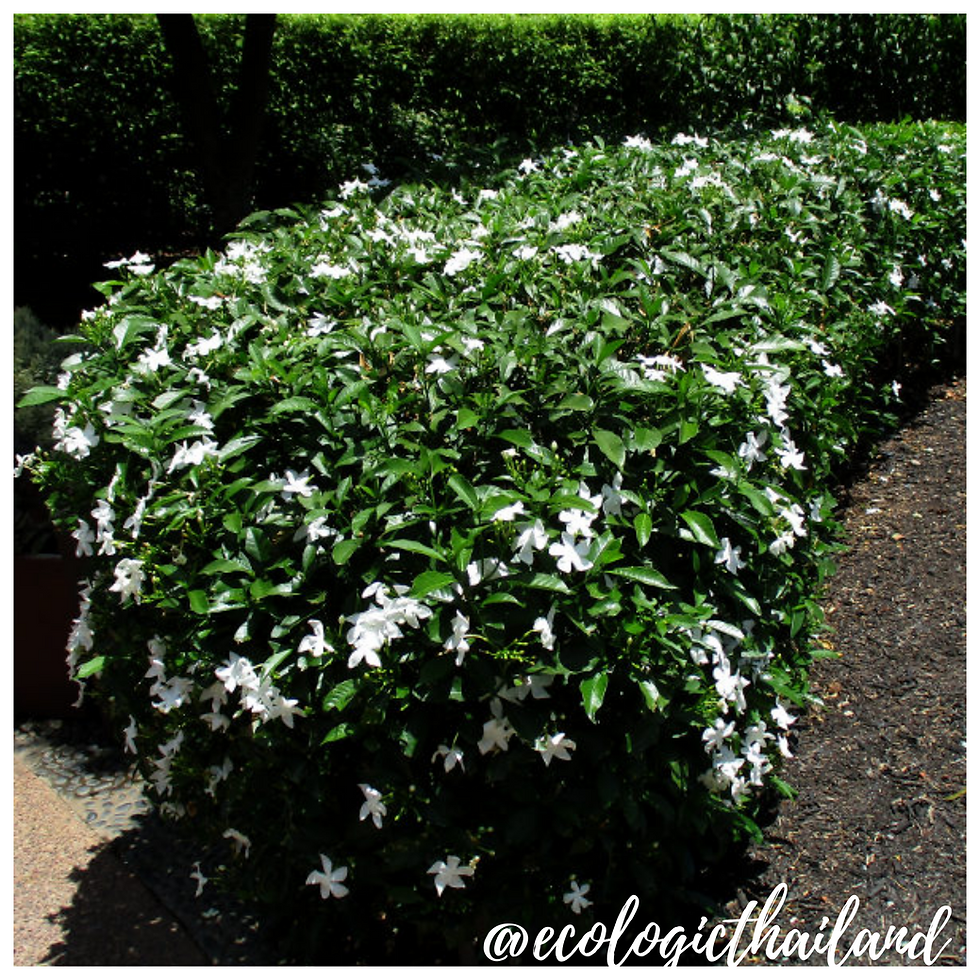Stevia
- Eco-Logic Resort
- Feb 12, 2021
- 3 min read
Updated: May 31, 2021
Ya-whan | หญ้าหวาน | Stevia rebaudiana
Family: Asteraceae - Genus: Stevia

Stevia is grown in and around the occupational training center and the social impact shop of TCDF.
Stevia is also know as candy leaf, sweet leaf or sugar leaf. It is a slender, erect, perennial plant growing around 30 to 60 centimeter tall. The plant has a vigorous rhizome and shallow root system. The plant is cultivated for its sweet-flavored edible leaves from which a sweetener can be extracted. The leaves contain a number of sweet-tasting chemicals known as steviol glycosides, which can be used fresh or dried to sweeten beverages or desserts or can be commercially processed into powdered noncaloric sweeteners. The sweetness of the plant is 200–300 times the sweetness of sugar. The plant also has medicinal uses.
It has elongated leaves that grow along the stems and are lined up against each other.
Harvesting of the leaves can be done at monthly intervals and can continue for about 5 years before the plants will need to be replaced. Flowering of the herb is from January to March.

THE PLANT
Stevia is a tender perennial herb that reaches 30–60 centimeter in height. The oblong aromatic leaves are 2.5 centimeter long with a prominent midrib and are arranged oppositely along the stems. The small tubular flowers have five white petals and are borne in terminal clusters; the flowers are usually removed to improve the flavor of the leaves. Germination from seed is difficult, and most plants are grown from cuttings.

THE LEAVES
Leaves of the stevia plant are oblong and aromatic, 2.5 centimeter long with a prominent midrib and are arranged oppositely along the stems.

THE FLOWERS
The flowers are white with light purple accents and no fragrance.
Flowers are trimmed to improve the taste of the leaves.
CULINARY USES
Use fresh or dried stevia leaves to sweeten tea. Add one small bit of leaf to hot water in combination with your other tea herbs to add a natural, earthy sweetness. Stevia will not steep in cold water so the water must be warm in order to release the sweetness.
The powdered leaves are also added to herb teas.
The leaves and extract of Stevia plant are used to sweeten different food stuffs, desserts, beverages, etc. across the globe. Sweet components responsible for intense sweetness are the Steviosides having sweetness ranging from 250 to 400 times sweeter as compared to sucrose
The leaves are sometimes chewed by those wishing to reduce their sugar intake. The leaves can also be cooked and eaten as a vegetable.
NUTRITION
Benefits related to stevia leaf are mostly due to their nutritional composition because it is a significant source of carbohydrates, protein and crude fiber that maintains the wellbeing and decrease the risk of various diseases.
TRADITIONAL MEDICINAL USE
Stevia has been studied in diabetic patients with impressive results. Stevia has also been shown to have anti-inflammatory, anti-cancer, diuretic and immunomodulatory effects. Being a non-carbohydrate sweetener, stevia would not favor the growth of Streptococcus mutans bacteria in the mouth which is attributed to be a causative agent of dental caries and tooth cavities. .
Stevia contains natural antioxidants which helps in lowering blood pressure, cholesterol, and control diabetes. Stevia is not a remedy for diabetes, but can be used as a sugar-free sweetener, and is reported to have some effect upon regulating glucose levels. The plant has also been used in the treatment of candidiasis, skin abrasions, dental caries, depression, hypertension, obesity, wound healing and as tonic and sweetener.
INTO THE WILD: a down to earth experience

For guests and visitors to Paksong we organize weekly tours "The Edible Forest" and Foraging weekends: Into the Wild. We work with local guides to take you in the jungle of Paksong. After foraging, we will cook a meal with the ingredients, using bamboo together with you!
Come and join and learn about the abundance of food that nature gives us!
INTO THE WILD!

















Comments